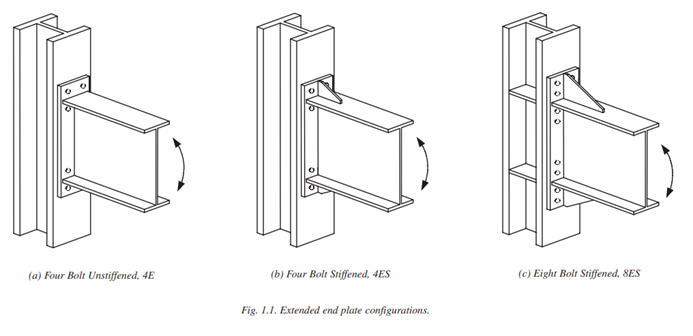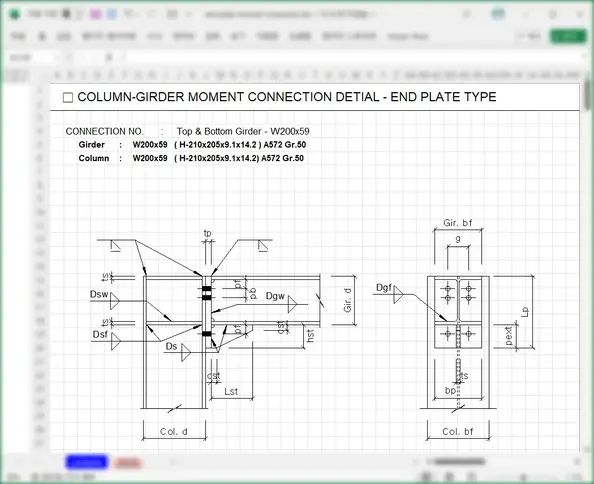Design and Practical Examples of End Plates

End Plate Moment Connection :
is one of the key joint methods used in steel structures to securely connect beams and columns. This method involves welding an end plate to the beam's end and using high-strength bolts to connect this plate to a column or another beam, allowing effective moment transmission. Below is a summary of the main concepts and characteristics of End Plate Moment Connection.

1. Components of End Plate Moment Connection
End Plate -
A steel plate welded to the beam's end, serving to fix the beam to another member (either a column or another beam).
High-Strength Bolts -
Used to securely fix the end plate to the connecting member. Typically, bolts conforming to ASTM A325 or ASTM A490 standards are used.
Stiffeners -
Additional reinforcements placed between the end plate and the beam flange to increase the stiffness of the joint and reduce the required thickness of the end plate. Stiffeners are not always mandatory but are used when necessary.
2. Types of End Plate Moment Connection
Flush Connection -
- The end plate does not extend significantly beyond the beam flange, and all bolts are placed between the beam flanges.
- Typically used for structures subjected to light lateral loads or near the inflection point of a frame.
Extended Connection -
- The end plate extends beyond the beam flange, allowing bolts to be placed outside the flange.
- Can be further categorized depending on whether stiffeners are used.
- Primarily used in moment connections between beams and columns.
3. Design Considerations for End Plate Moment Connection
Bolt Pitch -
The distance between bolts is designed with consideration for both economy and structural efficiency. A minimum pitch is recommended based on bolt diameter.End Plate Thickness -
Adequate thickness is required to effectively transfer the beam’s moment capacity. Adding stiffeners can reduce the required thickness.
Welding Design-
The welding between the beam's web and the end plate must be designed to withstand the yielding stress of the beam.
Shear Resistance-
Shear forces in the connection are mainly resisted by the bolts on the compression side. However, shear force is not a primary consideration in moment connection design.

4. Relevance to Seismic Design
End Plate Moment Connection plays an important role in seismic design. In seismic conditions, the structure must withstand repetitive loads caused by earthquakes, and the End Plate Moment Connection is designed to stably transfer moments under such cyclic loading. The following aspects are considered for seismic design:
Plastic Hinge Generation Location -
The location of plastic hinge formation varies depending on the type of End Plate Moment Connection.Strong Column-Weak Beam Design Concept -
This design philosophy enhances seismic performance by guiding plastic hinge formation in the beam.
Welding Design-
The welding between the beam's web and the end plate must be designed to withstand the yielding stress of the beam.
Shear Resistance-
Shear forces in the connection are mainly resisted by the bolts on the compression side. However, shear force is not a primary consideration in moment connection design.

